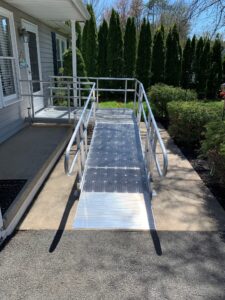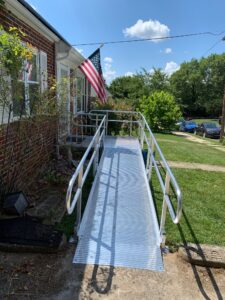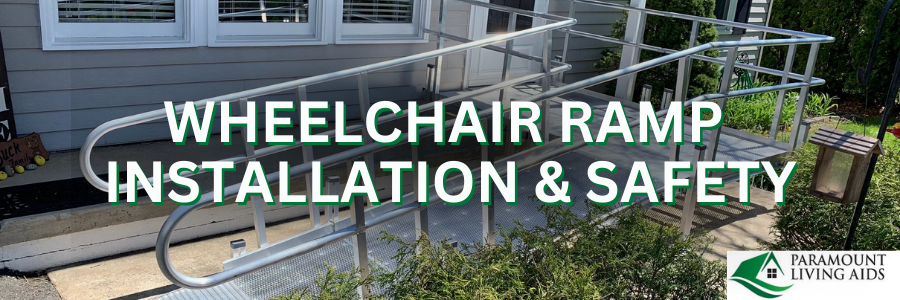Did you know that Ramps have been a part of history for a long time? For thousands of years, ramps have been critical tools used by many. Ramps help build infrastructure, educational institutions, and so much more. What Archimedes once dreamed up centuries ago continues to be an essential tool for many still to this day.
Wheelchair ramps are an essential part of everyday life for people who rely on them to get around. However, if not used or installed correctly, they can become hazardous.
Ready to make your home safer and more accessible? Check out our blog featuring top-notch tips for installing a wheelchair ramp – so that everyone can roll easily!
Degree of Incline & Ramp Length
The degree of incline is an important safety factor of your wheelchair ramp. The degree of incline determines how steep the ramp can be without being too dangerous. The ideal angle for a ramp is 4.8°.  Stopping points are recommended for longer lengths. The slower you go, the easier it will be to control direction and speed.
Stopping points are recommended for longer lengths. The slower you go, the easier it will be to control direction and speed.
You may select slightly steeper ramps for those who opt for a power chair or assisted device. It’s important to remember to be sure not to exceed the safety parameters of your wheelchair ramp.
Our technicians consider the degree of incline when designing and installing wheelchair ramps. This helps our clients feel safe and confident while using their wheelchair ramps.
Surface & Material
When it comes to wheelchair ramps, the surface and material need to be a consideration. Often it can mean a smooth and accessible journey up or down your ramp. Or if it can make the journey a more difficult one. At first glance, it may not seem like such an important detail. However, the choice of material and surface directly impacts the physical effort required, whether in pushing the wheelchair or maintaining balance while in transit.
Have you ever thought about using plywood to build your ramp? While it is possible, it is not recommended. There are better material choices when it comes to wheelchair ramps. Plywood becomes a safety concern when it gets wet. When wet, the ramp can become extremely slippery, and over time, the rainwater can cause the bonds between the laminates to weaken.
Handrails & Toe Guards
Handrails are vital additions to ramps and provide additional support for wheelchair users. Handrailings allow individuals to pull themselves up their ramp. It also offers a great way to prevent falls or slips.
 If your ramp is higher than 6 inches, having handrails and toe guards is essential for safety and stability. It’s essential to ensure that any ramps you use to meet all ADA requirements, including handrail placement and height. Toe guards add an extra layer of safety by preventing the user’s foot from slipping off the edge of the ramp. With the proper preparation, you can guarantee that your ramp is a safe and secure area for everyone.
If your ramp is higher than 6 inches, having handrails and toe guards is essential for safety and stability. It’s essential to ensure that any ramps you use to meet all ADA requirements, including handrail placement and height. Toe guards add an extra layer of safety by preventing the user’s foot from slipping off the edge of the ramp. With the proper preparation, you can guarantee that your ramp is a safe and secure area for everyone.
When correctly installed at a comfortable height, handrails offer reliable strength should one need further leverage while navigating the ramp safely.
Longevity
It’s easy to get overwhelmed with worry about the longevity of a ramp, but the reality is that your ramp does not have to be replaced every few years; it can last for many years so long as you take proper care of it. A good tip is to have a professional install and assess your ramp’s condition to ensure that minor repairs are made, which extends the ramp’s use while keeping you safe.
Installation
A ramp can differentiate between isolated confinement and freedom for those with mobility challenges. Paramount Living Aids has developed long-standing relationships with our customers, dedicating ourselves to ensuring your ramp is ready when needed. Most ramps take just a few hours to install.
Please fill out the form on our contact page for your FREE in-home estimate.

